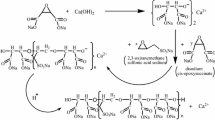Abstract
We have studied amphiphilic triblock copolymers poly(ethylene glycol)-b-poly(propylene glycol)-b-poly(ethylene glycol) (PEG-b-PPG-b-PEG) and poly(propylene glycol)-b-poly(ethylene glycol)-b-poly(propylene glycol) (PPG-b-PEG-b-PPG) as possible substitutes for sodium dodecyl sulfate as anionic surfactants for the removal of hydrophobic contaminants. The triblock copolymers were compared with sodium dodecyl sulfate in terms of their abilities to remove toluene as hydrophobic contaminant in fuel, and the effects of polymer structure, PEG content, and concentration were studied. The PEG-b-PPG-b-PEG copolymer containing two hydrophilic PEG blocks was more effective for the removal of hydrophobic contaminant at extremely high concentration. We also measured the removal capabilities of the triblock copolymers having various PEG contents and confirmed that removal capability was greatest at 10% PEG content regardless of polymer structure. As with sodium dodecyl sulfate, the removal efficiency of a copolymer has a positive correlation with its concentration. Finally, we proposed the amphiphilic triblock copolymer of PPG-b-PEG-b-PPG bearing 10% PEG content that proved to be the most effective substitute for sodium dodecyl sulfate.
Similar content being viewed by others
References
Alexandridis, P., J.F. Holzwarth, and T.A. Hatton, 1994, Micellization of poly(ethylene oxide)-poly(propylene oxide)-poly(ethylene oxide) triblock copolymers in aqueous solutions: thermodynamics of copolymer association, Macromolecules 27, 2414–2425.
Banks, M.K., P. Schwab, B. Liu, P.A. Kulakow, J.S. Smith, and R. Kim, 2003, The effect of plants on the degradation and toxicity of petroleum contaminants in soil: a field assessment, Adv. Biochem. Eng. Biotechnol. 78, 75–96.
Kim, J., C. Cohen, and M.L. Shuler, 2000, Use of amphiphilic polymer particles for in situ extraction of sorbed phenanthrene from a contaminated aquifer material, Environ. Sci. Technol. 34, 4133–4139.
Lee, J., J. Shim, and Y. Kim, 2014, Removal of hydrophobic contaminant using amphiphilic block copolymer, J. Korea Geo-Environ. Soc. 3, 15–19.
Liu, T., V.M. Nace, and B. Chu, 1997, Cloud-point temperatures of BnEmBn and PnEmPn type triblock copolymers in aqueous solution, J. Phys. Chem. B 101, 8074–8078.
Mackay, D.M. and J.A. Cherry, 1989, Groundwater contamination: Pump-and-treat remediation, Environ. Sci. Technol. 23, 630–636.
Meagher, R.B., 2000, Phytoremediation of toxic elemental and organic pollutants, Curr. Opin. Plant Biol. 3, 153–162.
Mulligan, C.N., R.N. Yong, and B.F. Gibbs, 2001, Surfactantenhanced remediation of contaminated soil: A review, Eng. Geol. 60, 371–380.
Palmroth, M.R.T., J. Pichtel, and J.A. Puhakka, 2002, Phytoremediation of subarctic soil contaminated with diesel fuel, Bioresource Technol. 84, 221–228.
Paria, S., 2008, Surfactant-enhanced remediation of organic contaminated soil and water, Adv. Colloid Interface Sci. 138, 24–58.
Prud’homme, R.K., G. Wu, and D.K. Schneider, 1996, Structure and rheology studies of poly(oxyethylene-oxypropyleneoxyethylene) aqueous solution, Langmuir 12, 4651–4659.
Reid, B.J., K.C. Jones, and K.T. Semple, 2000, Bioavailability of persistent organic pollutants in soils and sediments-a perspective on mechanisms, consequences and assessment, Environ. Pollut. 108, 103–112.
Shim, J.K., I.S. Park, and J.Y. Kim, 2007, Use of amphiphilic polymer nanoparticles as a nano-absorbent for enhancing efficiency of micelle-enhanced ultrafiltration process, J. Ind. Eng. Chem. 13, 917–925.
Tirtaatmadja, V., J.J. Cooper-White, and S.J. Gason, 2002, Shearinduced structure and dynamics of hydrophobically modified hydroxy ethyl cellulose (hmHEC) in the presence of SDS, Korea-Aust. Rheol. J. 14, 189–201.
Tsomides, H.J., J.B. Hughes, J.M. Thomas, and C.H. Ward, 1995, Effect of surfactant addition on phenanthrene biodegradation in sediments, Environ. Toxicol. Chem. 6. 953–959.
Wilhelm, K.P., G. Freitag, and H.H. Wolff, 1994, Surfactantinduced skin irritation and skin repair: Evaluation of a cumulative human irritation model by noninvasive techniques, J. Am. Acad. Dermatol. 31, 981–987.
Woo, D.K., B.C. Kim, and S.J. Lee, 2009, Preparation and rheological behavior of polystyrene/multi-walled carbon nanotube composites by latex technology, Korea-Aust. Rheol. J. 21, 185–191.
Yeh, C.K.J., H.M. Wu, and T.C. Chen, 2003, Chemical oxidation of chlorinated non-aqueous phase liquid by hydrogen peroxide in natural sand systems, J. Hazard. Mater. 96, 29–51.
Zhou, Z. and B. Chu, 1994, Phase behavior and association properties of poly(oxypropylene)-poly(oxyethylene)-poly(oxypropylene) triblock copolymer in aqueous solution, Macromolecules 27, 2025–2033.
Author information
Authors and Affiliations
Corresponding authors
Rights and permissions
About this article
Cite this article
Lee, J.H., Lee, B., Son, I. et al. Use of amphiphilic triblock copolymers for enhancing removal efficiency of organic pollutant from contaminated media. Korea-Aust. Rheol. J. 27, 319–323 (2015). https://doi.org/10.1007/s13367-015-0031-y
Received:
Revised:
Accepted:
Published:
Issue Date:
DOI: https://doi.org/10.1007/s13367-015-0031-y




